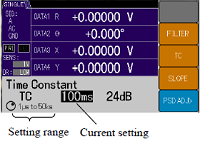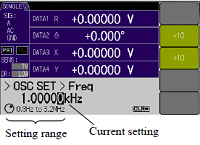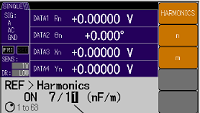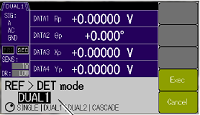03/11/2020 posted

The lock-in amplifier measures the amplitude and phase of an AC signal by combining a PSD (phase sensitive detector) and LPF (low-pass filter). Enter an AC "reference signal" and measure only signals of the same frequency. Even if the measurement signal contains AC noise, it is possible to remove the noise and measure the wanted signal only at the specific target frequency.
"DR" is known to represent the performance of a lock-in amplifier. Because the noise reduction capability of a lock-in amplifier is specified by DR (Dynamic Reserve).
The DR specification of NF's lock-in amplifier is 100 dB or above, which means even with a noise of 1 Vp-p superimposed on a 10 µV AC signal, the signal is still measurable. In other words, lock-in amplifiers have really high capability of removing noises.
In a general measurement environment, it is difficult to measure an amplitude signal smaller than the overwhelming background noise because there is residual noise of around mV for voltage and µA for current. However, lock-in amplifiers have excellent noise reduction capability, so they can measure very small noises.
And this is the minimum range of the measurement signal of NF's lock-in amplifier.
*"f" is femto = 10-15
It is possible to measure the phase difference between the measurement signal and the reference signal. The minimum resolution for phase measurement is 0.001°. It is possible to measure the phase difference between two signals, which also means the small time difference between two signals.
The PSD used in lock-in amplifiers can measure not only signals but also noise. The operation of the lock-in amplifier is equivalent to BPF (bandpass filter), the noise can be measured by setting the BPF band.
The measurement signal and reference signal are
converted into digital signals after input, and PSD and LPF are mainly processed by
digital arithmetic.
And digital arithmetic has the following performance and functional advantages.
The minimum setting for "Time Constant" is very short. And this means that a fast response is possible.
It is suitable for signal processing for microscopes such as AFM, which requires high-speed image processing.

The LI5660 has a maximum frequency of 11 MHz. Also, the LI5650 and LI5645 have a minimum frequency of 1 mHz.
The low frequencies on the order of milli-hertz are suitable for deep-level transient analysis of semiconductor properties such as DLTS.

Dual PSD can measure signal amplitude and phase at the same time without phase adjustment.
The normal measurement mode can measure the reference signal frequency; however, the dual frequency measurement function can measure another frequency at the same time in addition to the reference signal frequency.


In "differential measurements", 2 units of regular lock-in amplifiers are typically required, although 1 unit of lock-in amplifier with a dual frequency can solve that problem alone.
The output data can be displayed or acquired by the following methods.
By increasing the time constant setting, lock-in amplifiers can measure very small signals obscured by noise that is a lot larger. Increasing the time constant will increase the measurement time, and this cannot be shortened with the lock-in amplifier alone. However, by connecting another filter or preamplifier before the lock-in amplifier, the SN ratio of the input signal of the lock-in amplifier may be improved and the measurement time may be shortened.
NF offers a variety of preamplifiers that are the
best fit for sensors and filters with different frequency cutoff characteristics. The
connection with peripheral devices to the main unit is very easy, e.g. equipping the lock-in
amplifier with a power supply for the preamplifier.
With "preamplifier + lock-in amplifier" or "filter + lock-in amplifier", the performance is
expected to improve even further.
Recent post